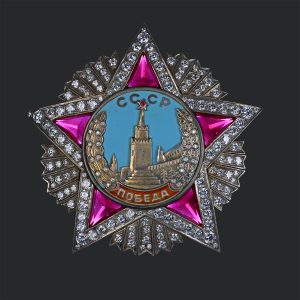The Order of Victory (or Orden Pobeda), as pictured above, was a prestigious Soviet military decoration of the highest order. The Orden Pobeda, as it was referred to in Russian, was exclusively awarded to Marshals and Generals for their extraordinary World War II service. The medallion itself is an incredibly rare decoration, given that there are only 22 copies in existence. The first time the Order was presented to anyone was in 1944, and last time the Order was presented was in 1978.
Throughout the tenure of the USSR, the Order of Victory had only been presented a total of 20 times. The esteemed medallion was awarded only to Generals and Marshals in World War II who significantly shaped and enabled the Red Army’s victory.

Historically, there have been 12 Soviet military leaders and five foreign military leaders who have been the recipients of the Order. The five foreign leaders include Dwight Eisenhower of the USA, Josip Tito of Yugoslavia, Bernard Montgomery of the United Kingdom, Michael I of Romania and Michał Rola-Żymierski of Poland. Throughout the history of the Medallion, three of the recipients were awarded twice, while one recipient had his award revoked. King Michael I of Romania was the last living recipient of the Order; he was awarded the medallion on July 6th 1945 and died in December of 2017.
CONTROVERSY #1:
BREZHNEV GETS THE ORDER REVOKED
Learn more about the fascinating history of arms and weaponry

Though the Order is considered an enormous honor, there have been several controversies surrounding the decoration. One of which is the case of former Soviet General Secretary, Leonid Ilyich Brezhnev, who was awarded in 1978 and had his award annulled after his death. The case of Brezhnev is an interesting one given that it was presented to him while he was the General Secretary himself. Thus it is considered that he awarded it to himself in vain.
Brezhnev’s award was revoked in 1989 by Gorbachev, after it was deemed that Brezhnev’s participation in the war did not qualify him for such a distinction. Brezhnev only held managerial roles in the army and never reached the rank of a Lieutenant. Nor did he assist in any crucial WWII battles. Moreover, the general unpopularity of Brezhnev after his incumbency helped prompt the revocation.
Despite Brezhnev’s posthumous Order annulment, Brezhnev is still one of the most decorated figures in Soviet history. Brezhnev was awarded four gold star Hero of the Soviet Union medals and one gold star Hero of the Socialist Labor medal.
THE DESIGN OF THE ORDER & THE FIRST AWARDEES

The Order was first established on November 8th, 1943, just a few months after it was first suggested by colonel Colonel N. S. Neyelov in June of that year. The idea behind the Order came after the Soviets experienced one of their first decisive victories of the war in the Battle of Stalingrad.
In October of 1943, Soviet artist Alexander I. Kuznetsov, who had also designed the Patriotic War Medallion, delivered the first draft of the Order to the General Secretary at the time, Joseph Stalin. However, Stalin was not pleased and requested that Kuznetsov design several other prototypes.
Initially, Kuznetsov included portraits of both Lenin and Stalin, which Stalin did not approve of. Instead, Stalin requested one featuring the Spasskaya Tower, the main tower in the Kremlin. After seeing a few more of Kuznetsov’s drafts, Stalin ended up choosing a design with ‘Pobeda’ (Victory) written beneath the tower and ‘CCCR’ (USSR) written above. Stalin was so impressed by the sample of the medallion, he kept this version for himself.
The first three recipients of the order were Marshal Georgy Zhukov, Marshal Aleksandr Vasilevsky and Secretary General Joseph Stalin, who were awarded the medallion in a collective ceremony on April 10th, 1944 after liberating the right bank of Ukraine from the Nazis. The three were also awarded the honor a second time, in 1945 just after the end of the war.
Tragically, one recipient never lived to get knighted with his medallion. General Ivan Chernyakhovsky died just 5 days before he was supposed to receive it.
THE MOST EXPENSIVE
MILITARY DECORATION IN THE WORLD
The Order was first established on November 8th, 1943, just a few months after it was first suggested by colonel Colonel N. S. Neyelov in June of that year. The idea behind the Order came after the Soviets experienced one of their first decisive victories of the war in the Battle of Stalingrad.
In October of 1943, Soviet artist Alexander I. Kuznetsov, who had also designed the Patriotic War Medallion, delivered the first draft of the Order to the General Secretary at the time, Joseph Stalin. However, Stalin was not pleased and requested that Kuznetsov design several other prototypes.
Initially, Kuznetsov included portraits of both Lenin and Stalin, which Stalin did not approve of. Instead, Stalin requested one featuring the Spasskaya Tower, the main tower in the Kremlin. After seeing a few more of Kuznetsov’s drafts, Stalin ended up choosing a design with ‘Pobeda’ (Victory) written beneath the tower and ‘CCCR’ (USSR) written above. Stalin was so impressed by the sample of the medallion, he kept this version for himself.
The first three recipients of the order were Marshal Georgy Zhukov, Marshal Aleksandr Vasilevsky and Secretary General Joseph Stalin, who were awarded the medallion in a collective ceremony on April 10th, 1944 after liberating the right bank of Ukraine from the Nazis. The three were also awarded the honor a second time, in 1945 just after the end of the war.
Tragically, one recipient never lived to get knighted with his medallion. General Ivan Chernyakhovsky died just 5 days before he was supposed to receive it.
CONTROVERSY #2:
MYTH OF EISENHOWER’S MEDAL
In addition to the story of Brezhnev’s revocation, one of the most fascinating tales surrounding this Order is when American President Dwight Eisenhower allegedly took his Order to get appraised by an American jeweler and was told that the stones in his medallion were not genuine. Whether or not this is true has never been confirmed, however, Prince Bernard of the Netherlands claims that Eisenhower told him this story himself.
WHERE ARE THESE MEDALS NOW?
Most of the medals in existence are on display in Russia, because after a recipient dies the medallion gets repossessed by the state. Within the museums of the Moscow Kremlin, you can find 8 Order of Victory medallions, which is the largest collection of these medals in the world. There is one un-awarded medallion in the State Hermitage in St Petersburg as well as two medallions (one awarded to Semyon Timoshenko and one never awarded) stored in the Russian State Diamond Fund (Gokhran).
Bernard Montogmery’s medallion is on display at the Imperial War Museum in London. Dwight Eisenhower’s medallion is on display in Kansas at the Dwight D. Eisenhower Presidential Library, Museum and Boyhood Home. Meanwhile, Josip Broz Tito’s medallion is on display at the Museum of Yugoslav History in Belgrade, Serbia.
CONTROVERSY #3:
THE UNKNOWN LOCATIONS OF TWO MEDALS
Despite many of these medallions being on public display, there are still some questions about the whereabouts of several copies. It is still unknown exactly where Polish military leader’s Michał Rola-Żymierski’s medallion is stored. Moreover, while it is alleged that Michael I of Romania’s medal is kept somewhere in his estate in Geneva, there are several rumors that the medal was sold in the 1980s for around $4 million dollars.






